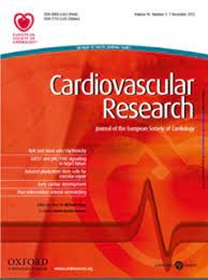Dedicator of Cytokinesis 2 regulates cytoskeletal actin dynamics and is essential for platelet biogenesis and functions
IF 10.2
1区 医学
Q1 CARDIAC & CARDIOVASCULAR SYSTEMS
引用次数: 0
Abstract
Aims Dedicator of Cytokinesis 2 (DOCK2), a member of the DOCK family of Guanine nucleotide exchange factors that specifically act on the Rho GTPases including Rac and Cdc42, plays pivotal roles in the regulation of leukocyte homeostasis. However, its functions in platelets remain unknown. Methods and Results Using mice with genetic deficiency of DOCK2 (Dock2-/-), we showed that Dock2-/-mice exhibited a macrothrombocytopenic phenotype characterized as decreased platelet count and enlarged platelet size by transmission electron microscopy. Dock2-/- megakaryocytes had reduced polyploidization determined by propidium iodide staining and defective proplatelet formation by confocal microscopy. DOCK2 deficiency led to enriched F-actin level in resting platelets but defective F-actin assembly in activated platelets by phalloidin staining, and mechanistically, attenuated activity of Rac1, unchanged Cdc42 but enhanced RhoA measured by immunoprecipitation of GTP-bound proteins. Immunoblotting analysis showed that Dock2-/- platelets had reduced Immunoreceptor Tyrosine-based Activation Motif signaling downstream of impaired clustering of GPVI receptors determined by stochastic optical reconstruction microscopy. Further, DOCK2 deficiency resulted in reduced density and branches of fibrin fibers in the clots in vitro and diminished platelet aggregation in a microfluidic chamber ex vivo. Dock2-/- platelets exhibited impaired incorporation into a growing thrombus in cremaster arterioles following allogeneic transfusion into a WT recipient, and defective heterotypic interactions with neutrophils in cremaster venules as reflected by decreased platelet-neutrophil aggregate formation in vitro under stirring condition. In addition, myeloid deficiency of DOCK2 caused prolonged tail bleeding times. Finally, pharmacological inhibition of DOCK2 using a small-molecular inhibitor CPYPP suppressed actin dynamics leading to impaired responses to GPVI activation, and defects in platelet spreading, clot retraction, and thrombus formation. Conclusions DOCK2 plays critical roles in the regulation of platelet biogenesis and functions by controlling Rac1 activity and cytoskeletal actin dynamics, and may be a novel target for the treatment of thrombotic and thrombo-inflammatory diseases.细胞分裂奉献因子2调节细胞骨架肌动蛋白动力学,对血小板的生物发生和功能至关重要
DOCK2是鸟嘌呤核苷酸交换因子DOCK家族的一员,特异作用于Rho gtpase,包括Rac和Cdc42,在调节白细胞稳态中起关键作用。然而,其在血小板中的功能尚不清楚。方法和结果利用DOCK2基因缺陷小鼠(DOCK2 -/-),通过透射电镜观察,我们发现DOCK2 -/-小鼠表现出血小板数量减少和血小板大小增大的大血小板减少表型。碘化丙啶染色检测Dock2-/-巨核细胞多倍体化减少,共聚焦显微镜检测血小板形成缺陷。DOCK2缺乏导致静止血小板中f -肌动蛋白水平升高,但激活血小板中f -肌动蛋白组装缺陷(通过phalloidin染色),并且在机制上,Rac1活性减弱,Cdc42不变,但通过免疫沉淀gtp结合蛋白测量的RhoA增强。免疫印迹分析显示,Dock2-/-血小板在随机光学重建显微镜下检测到GPVI受体聚集受损下游的免疫受体酪氨酸激活Motif信号减少。此外,DOCK2缺乏导致体外凝块中纤维蛋白纤维密度和分支减少,体外微流控室中血小板聚集减少。同种异体输注到WT受体后,Dock2-/-血小板被破坏融入到cremaster小动脉中正在生长的血栓中,并且在体外搅拌条件下血小板-中性粒细胞聚集形成减少,反映了与cremaster小动脉中中性粒细胞异型相互作用的缺陷。此外,髓系缺乏DOCK2导致尾出血时间延长。最后,使用小分子抑制剂CPYPP对DOCK2进行药理学抑制,抑制了肌动蛋白动力学,导致对GPVI激活的反应受损,以及血小板扩散、凝块缩回和血栓形成的缺陷。结论DOCK2通过控制Rac1活性和细胞骨架肌动蛋白动力学,在血小板生物发生和功能调控中发挥关键作用,可能成为治疗血栓性和血栓炎性疾病的新靶点。
本文章由计算机程序翻译,如有差异,请以英文原文为准。
求助全文
约1分钟内获得全文
求助全文
来源期刊

Cardiovascular Research
医学-心血管系统
CiteScore
21.50
自引率
3.70%
发文量
547
审稿时长
1 months
期刊介绍:
Cardiovascular Research
Journal Overview:
International journal of the European Society of Cardiology
Focuses on basic and translational research in cardiology and cardiovascular biology
Aims to enhance insight into cardiovascular disease mechanisms and innovation prospects
Submission Criteria:
Welcomes papers covering molecular, sub-cellular, cellular, organ, and organism levels
Accepts clinical proof-of-concept and translational studies
Manuscripts expected to provide significant contribution to cardiovascular biology and diseases
 求助内容:
求助内容: 应助结果提醒方式:
应助结果提醒方式:


